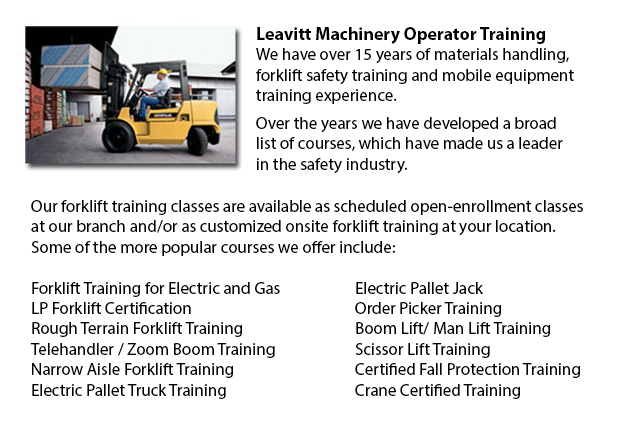
Rough Terrain Forklifts Training Oakville - There are actually two distinctive classifications of forklifts within the material handling industry, the industrial model and the rough terrain model. Rough terrain forklifts originally came on the marketplace in the 1940's and had been primarily used on coarse roads, ideal for areas where no covered surfaces were accessible, like construction sites and lumberyards.
Usually, the majority of rough terrain forklifts are run on a propane, diesel or gasoline powered internal combustion engines with a battery used for power. Many suppliers are experimenting with rough terrain lift trucks that utilize vegetable matter and run from ethanol. Large pneumatic tires with deep treads characterize these forklifts to permit them to clutch onto the roughest soil type devoid of any misstep or shifting.
The most basic versions of all terrain lift trucks were able to transport weights of up to 1000 lbs, via blades that could run under the item, raise it a slight bit and then transfer it to an alternate location. After a decade on the market, all terrain lift trucks had been given additional shipping power to about 2000 lbs capacity. Telescoping booms were added in the 1960's, enabling them to stack resources a great deal higher than in preceding years. The telescoping model feature is a staple of most all terrain lift trucks nowadays. Present styles are capable of managing well over 4000 lbs thanks to the continual improvements through the years. Telescoping capability has additionally improved with some versions attaining a height of 35 feet. Worker safety has also become a focus with a lot of rough terrain lift trucks now manufactured are equipped with an enclosed cab for the operator, versus the older open air seating capacity.
The all terrain lift trucks on the market these days both run admirably on unpaved roads and paved floors. This style of all terrain lift truck is marketed for its' flexibility enabling the opportunity for organizations to use one unit to transport resources from an outside working site into a warehouse.
-
JLG Telehandler
JLG Telehandler Training Oakville - Following retirement in the late 1960's, John L. Grove started on a cross country RV expedition. After spending numerous years establishing his family built crane business with his brother, John had no idea that th... More -
Doosan Forklift
Doosan Forklift Training Oakville - Doosan Infracore Company Ltd. is a transnational organization consisting of Diesel Engines, Defense Industry goods, Industrial Vehicles, Construction Technologies and Machine Tools and Computerization Systems.... More -
Genie Forklift
Genie Forklift Training Oakville - Genie is a universally established company that enjoys the spirit of alliance with their vast network of connected consumers. Genie Industries prides itself on the idea of bringing materials and people higher and ex... More -
Scissor Lifts
Scissor Lift Training Oakville - The scissor lift, often identified as a table lift, is an industrialized lift that has been tailored for use within wholesale and retail settings. Industrial platform lifts have been utilized for decades in the manufa... More -
Komatsu Forklift
Komatsu Forklift Training Oakville - Komatsu Forklift U.S.A. Inc. has a very good reputation for building reliable and robust lift trucks. Komatsu is recognized around the globe as a corporation with a prosperous heritage while maintaining an admirab... More

Forklift Training Oakville
TOLL FREE: 1-888-254-6157
Oakville, Ontario
forklifttrainingoakville.com
Email Us
About Us


